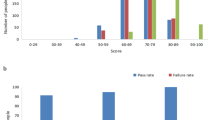Abstract
To meet the assessments requirements during the COVID-19 epidemic, many schools adopted the large-scale blended online examination, in which teachers invigilate through online video and students answer questions with pen and paper. Exploring the factors that influence students’ acceptance of the blended online examination will help the exam service understand the characteristics of students’ adoption and provide better support for staffs. It will help teachers and parents to assist students to take the blended examination and maintain the traditional exam atmosphere that will facilitate students’ learning performance and effectiveness. In this study, a questionnaire survey and structural equation method were adopted to explore the influence of perceived ease of use, perceived usefulness, social presence, place presence, and social influence on learners’ acceptance of blended online examination. Data analysis of 760 college students who underwent a blended online examination showed that perceived ease of use had a significant negative direct impact on exam acceptability and overall had a significant negative impact. Perceived usefulness, social presence, and social influence have significant positive effects on exam acceptability and social presence and social influence also have significant positive effects indirectly by influencing perceived usefulness. Finally, the limitations of this study are discussed, and the implications and future direction are put forward.
Access this chapter
Tax calculation will be finalised at checkout
Purchases are for personal use only
Similar content being viewed by others
References
Myyry, L., Joutsenvirta, T.: Open-book, open-web online examinations: developing examination practices to support university students’ learning and self-efficacy. Active Learn. High. Educ. (2015)
Stowell, J.R., Bennett, D.: Effects of online testing on student exam performance and test anxiety. J. Educ. Comput. Res. 42(2), 161–171 (2010)
Davis, F.D., Bagozzi, R.P., Warshaw, P.R.: User acceptance of computer technology: a comparison of two theoretical models. Manage. Sci. 35(8), 982–1003 (1989)
Canziani, B., MacSween, S.: Consumer acceptance of voice-activated smart home devices for product information seeking and online ordering. Comput. Hum. Behav. 119, 15 (2021)
Al-Emran, M.: Evaluating the use of smartwatches for learning purposes through the integration of the technology acceptance model and task-technology fit. Int. J. Hum.-Comput. Interact. (2021)
Shin, N.: Online learner’s ‘flow’ experience: an empirical study. Br. J. Edu. Technol. 37(5), 705–720 (2010)
Webster, J., Hackley, P.: Teaching effectiveness in technology-mediated distance learning. Acad. Manage. J. (1997)
Akour, H.: Determinants of Mobile Learning Acceptance: an Empirical Investigation in Higher Education. ProQuest LLC, Ann Arbor, MI. http://www.proquest.com/en-US/products/dissertations/individuals.shtml (2009)
Joo, Y.J., Lim, K.Y., Kim, E.K.: Online university students’ satisfaction and persistence: examining perceived level of presence, usefulness and ease of use as predictors in a structural model. Comput. Educ. 57(2), 1654–1664 (2011)
Parker, E.B., Short, J., Williams, E., Christie, B.: The social psychology of telecommunication. Contemp. Sociol. 7(1), 32 (1978)
Akyol, Z., Garrison, D.R.: The development of a community of inquiry over time in an online course: understanding the progression and integration of social, cognitive and teaching presence. J. Asynchron. Learn. Netw. 12(3), 3–22 (2008)
Garrison, D.R., Anderson, T.: E-Learning in the 21st Century: A Framework for Research and Practice. Routledge (2003)
Gunawardena, C.N.: Social presence as a predictor of satisfaction within a computer‐mediated conferencing environment. Am. J. Dist. Educ. 11(3) (1997)
Palloff, R.M., Pratt, K.: Building online learning communities. Technol. Pedagog. Educ. 14(3), 353–369 (2007)
Cobb, S.C.: Social presence, satisfaction, and perceived learning of RN-to-BSN students in web-based nursing courses. Nurs. Educ. Perspect. (Natl. League Nurs.) 32(2), 115–119 (2011)
Kang, M., Kang, J.: Investigating the relationships of social presence, satisfaction and learning achievement in the blended learning environment. EMBO J. 16(23), 6985–6995 (2008)
Ogonowski, A., Montandon, A., Botha, E., Reyneke, M.: Should new online stores invest in social presence elements? The effect of social presence on initial trust formation. J. Retail. Consum. Serv. 21(4), 482–491 (2014)
Biocca, F., Harms, C., Burgoon, J.: Toward a more robust theory and measure of social presence: review and suggested criteria. Presence 12(5), 456–480 (2003)
Sheridan, T.B.: Musings on telepresence and virtual presence. Presence Teleop. Virt. Environ. 1(1), 120–125 (1992)
Bulu, S.T.: Place presence, social presence, co-presence, and satisfaction in virtual worlds. Comput. Educ. 58(1), 154–161 (2012)
Hossain, A., Quaresma, R., Rahman, H.: Investigating factors influencing the physicians’ adoption of electronic health record (EHR) in healthcare system of Bangladesh: an empirical study. Int. J. Inf. Manage. 44, 76–87 (2019)
Wu, B., Zhang, C.: Empirical study on continuance intentions towards E-learning 2.0 systems. Behav. Inf. Technol. 33(10–12), 1027–1038 (2014)
Wu, B., Chen, X.: Continuance intention to use MOOCs: integrating the technology acceptance model (TAM) and task technology fit (TTF) model. Comput. Hum. Behav. 67, 221–232 (2016)
Davis, F.D.: Perceived usefulness, perceived ease of use, and user acceptance of information technology. Manag. Inf. Syst. Q. 13(3), 319–340 (1989)
Shea, P., Bidjerano, T.: Learning presence: towards a theory of self-efficacy, self-regulation, and the development of a communities of inquiry in online and blended learning environments. Comput. Educ. 55(4), 1721–1731 (2010)
Slater, M., McCarthy, J., Maringelli, F.: The influence of body movement on subjective presence in virtual environments. Hum. Factors (2016)
Zainab, A.M., Kiran, K., Karim, N.H.A., Sukmawati, M.: UTAUT’s performance consistency: empirical evidence from a library management system. Malays. J. Libr. Inf. Sci. 23(1), 17–32 (2018)
Lin, W.-S., Wang, C.-H.: Antecedences to continued intentions of adopting e-learning system in blended learning instruction: a contingency framework based on models of information system success and task-technology fit. Comput. Educ. 58(1), 88–99 (2012)
Author information
Authors and Affiliations
Corresponding author
Editor information
Editors and Affiliations
Rights and permissions
Copyright information
© 2022 The Author(s), under exclusive license to Springer Nature Singapore Pte Ltd.
About this paper
Cite this paper
Jiang, Xy., Goh, TT., Liu, Mj. (2022). College Students’ Blended Online Examination Acceptance During the COVID-19 Epidemic. In: Mealha, Ó., Dascalu, M., Di Mascio, T. (eds) Ludic, Co-design and Tools Supporting Smart Learning Ecosystems and Smart Education. Smart Innovation, Systems and Technologies, vol 249. Springer, Singapore. https://doi.org/10.1007/978-981-16-3930-2_11
Download citation
DOI: https://doi.org/10.1007/978-981-16-3930-2_11
Published:
Publisher Name: Springer, Singapore
Print ISBN: 978-981-16-3929-6
Online ISBN: 978-981-16-3930-2
eBook Packages: Intelligent Technologies and RoboticsIntelligent Technologies and Robotics (R0)




